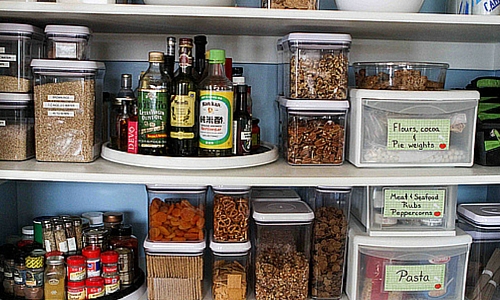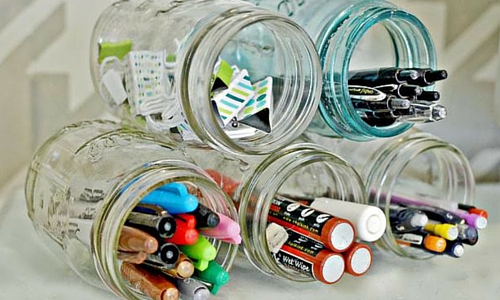Life is filled with so much stuff. Walk into the average home and you’ll find drawers, closets, basements, or storage lockers filled with things. Life is busy and it’s easy to just throw items in whatever junk place (or places) you have. Over the course of a couple weeks (or months or years), you can compile quite the menagerie of stored and quasi-discarded items. Not to mention the general clutter of everyday life; items that you use daily, which never seem to end up back where they belong.
This spring, consider taking a few hours to do some household organizing, as it can help save you time, space, and probably sanity too. It could even help you save some money – who knows what you have hiding in the corners of your basement closets? You might end up finding something you need (and forgot you already owned), and now you’ll no longer have to buy it (again)!
Great reasons to organize
Decluttering and organizing your living spaces can help with peace of mind and mental well-being. Mess and clutter can make us feel like there is always something to be done and makes it difficult to relax.
Organization saves time – when everything has a place you know where to look and can eliminate the time it takes searching your brain and your home for those extra ink cartridges and light bulbs.
Organizing your accumulated wealth of stuff helps you to take “inventory” of what you have. This could stop you from purchasing items you already have, but forgot about. It may also inspire you to find new uses for old “junk.”
And of course, organization looks clean and pretty!
Tips for getting organized
We know it can feel scary or overwhelming when you first start to clean and organize after a winter of stuff, so we put together a few tips to help you get started.
1. Make it a family affair.
Everyone has to participate in the afternoon’s organization event. Many hands make for lighter work, and it’s helpful having the family on hand to help sort through what has to be kept and what can be thrown away or donated.
Be sure to work in some rewards for the kids and yourself to help encourage active participation. (Hint: with spring and summer around the corner, ice cream season is almost here!)

2. Start a donation box.
Speaking of donating, make sure to set aside anything you no longer need that is in decent shape, so you can donate it to your local second-hand store or your preferred charity. And after you’ve dropped it off, try keeping a donation box in the house all the time, so you and the kids can add to it whenever you want. (Just don’t let these boxes sit around for another year themselves.)
3. Take it one room at a time.
You don’t have to do your whole home in one fell swoop. To start, you can either tackle your messiest, least organized space, such as that half-forgotten room or corner of the basement where impulse buys, unused camping gear, and outgrown kids clothing goes to steep in dust and unfulfilled (or wasted) potential.
You can also tackle a less daunting space first, like a commonly used space shared by all. That way at the end you get to continuously see the fruits of your labour, which could help keep you inspired to stay organized.

4. Be brave. Be harsh. Get rid.
Prepare yourself to get rid of things that you just don’t use anymore. Set out some guidelines ahead to help you decide what should go before you get into the thick of it.
It may be hard to part with some things due to nostalgia, or a hope that you will actually one day go ice climbing again. So yes, you definitely, absolutely still need those ice picks and crampons? But stay strong; if you haven’t used something in the past five years, how likely is it that will you use it again in the next five? Will the item still be good or safe to use in six months? One year? Five years?
If there are things you simply aren’t ready to part with because you think you will use them again, consider creating a new spot or box for storing these items and set a time line. Commit to using them within the next year or they get donated or ditched.
5. Commit to doing research and buying once.
There are a lot of products on the market that are not built to last. Different brands offer different levels of quality and longevity. Sure, it can be hard to put down a little more money upfront, but over the long-term and if you can manage it, investing in quality can really save you money because you won’t have to replace everything a year later.
When you’re thinking about buying a new appliance, piece of clothing, toy, or electronic, take some time to research your different options and read user reviews (Amazon.ca can be very helpful with this!). Purchase the highest quality you can, and look for items that can serve multi-purposes.
Ask yourself questions like, Do you need a blender and a mini blender? or Is there one item that can do everything? Buying fewer things saves money and space in your home, both of which tend to be in short supply.
6. Repurpose household items as organizational aids.
Empty and cleaned peanut-butter containers are great for storing small items, from nails and screws to marbles and craft supplies. Glass jars are also great for this, and work well in the kitchen storing nuts, flour, and other dried goods.
Magazine and paper organizers from the office can also be great in the pantry for storing packages of spaghetti or rolls of foil and plastic wrap. Many things can be repurposed; it just takes a little creativity (and perhaps a search on Pinterest for some inspiration.)
Organization ideas by room
There is so much variety out there when it comes to organization style and options. Here are a couple ideas to help get you started.

Pantry organization
Revamp your pantry by pulling everything out, cleaning the shelves, and sorting through the loot. Donate non-perishables you don’t think you’ll use, toss the years- old, half-finished boxes of pasta and bottles of condiments, and organize what’s left.
Restock with a plan that works for you and how you use your pantry. Rotating trays, containers, baskets, and racks can help you find a neat and tidy home for everything. After it’s organized, it’s just a matter of sticking to the plan. (Take a look at these great tips from Cookin Canuck for more ideas.)

Living room organization
Living and family rooms can be tricky to organize because they are often frequently used and multi-purpose rooms. Here are some tips for getting your living room organized.
If you have the space, designate areas for the different main uses of the room (such as watching TV, play area, reading, etc.). Distribute furniture, electronics, and décor to reinforce these spaces and their uses.
Minimize the stuff that collects on flat surfaces; a lot of clutter comes from a day’s worth of books, papers, cups and dishes, and toys accumulating on the coffee and side tables. Have a nice box or container where your remotes can go so they don’t get strewn across the room.
Shelving units with containers (bowls, baskets, etc.) can help to keep stuff off the flat surfaces and adds visual interest to the room. Considering also picking up a small wastebasket and recycling bin for the family room, so things meant for the garbage don’t collect in the room.
Utilize the storage capacity of your coffee table. If it doesn’t already have draws, consider rolling baskets or boxes that could fit under the table for things like extra blankets, coasters, or books and magazines.
Cords going to electronics, especially towards an entertainment unit, can create a lot of visual clutter and be an organizational nightmare (not to mention a tripping hazard for the kids!). There are handy tools that can help with these, like cable yoyos (they wrap up extra cord), or a cable zipper that can collect multiple cables into one clean covered cord. (Take a look at these organization pics from iHeart Organizing for inspiration.)

Office organization
An office or a study can be an important part of the home, especially if you do any work from home. Offices clutter up quickly when life is busy, so here are some ideas to help keep it organized.
If you don’t already, invest in a filing cabinet. Keeping your files organized will save you many headaches come tax season, or when you need old medical files, or information on your mortgage or home renovations. Make a point to file papers away daily or even weekly so that they don’t build up and become unmanageable.
Establish a filing system so you know exactly where to look for each different document you need to find. You can organize based on what needs to be accessed regularly versus once a year versus rarely. You can also group together relevant categories – keep files related to house and home together, taxes together, and so on. It’s also important to purge old files that you don’t need to keep; 10-year-old visa statements are definitely just clutter at this point.
If space is a limiting factor, there are many small space office solutions, from contained desks that can be closed off as an armoire, to using sturdy shelves for your computer surface needs. Make use of vertical space with tall shelving and storage where you aren’t able to expand out.
Keep your drawers and shelves organized by using small mason jars to organize elastics, push pins, pens and pencils, and various other odds and ends that collect in an office space (Check out It’s Overflowing to see how it’s done). Drawer dividers, which you can purchase or DIY with cereal boxes and wrapping paper, are really helpful at keeping drawers neat and well sorted.
Be sure to take some time this spring to refresh a room or two (or more!) in your house with some updated organization. Grab the kids and get to work – your brain and future-self will thank you for it!
Jen Vander Vecht is a writer and soon to be full-time mom. When not crafting four different knitting projects at once, she can be found dumping ingredients into her slow-cooker, walking the dog, watching Doctor Who, or researching cloth diapers.
READ MORE LIKE THIS:
- 6 Easy and Inexpensive Shoe Storage Solutions
- 9 Ideas for Organizing Kids’ Books
- 11 Simple Solutions to Organize Toy Clutter
Get inspiration for your home from our Around the House coverage, and find someone to help you in our Toronto Professional Organizers directory.
Sign up for our newsletters to get parenting and family fun articles delivered to you!





